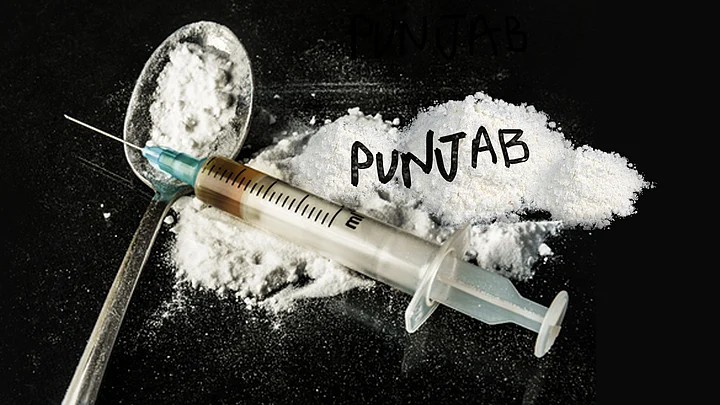Udta Punjab highlights multiple social and ecological crises being unleashed, owing to a non-sustainable model of industrial chemical farming misleadingly named the Green Revolution. There is a sequence in the film where policemen at a checkpoint stop a truck loaded with drugs. They refer to drug menace as the beginning of the “Green Revolution 2.2” and go on to equate Punjab with Mexico.
The Green Revolution, which began in Punjab, was given a Nobel Peace prize based on the narrative that new seeds and chemicals would create prosperity and hence peace. But by 1984, Punjab was a land of violence and war. 30,000 people had been killed.
It was this divergence between the Green Revolution myth and the reality of violence that compelled me to conduct a research on what was happening in Punjab.
How Chemicals Ruined Farmers’ Lives
The Green Revolution is based on addiction of soil and farmers to ecological narcotics — the chemical fertilisers and pesticides. The more they are used, the more they are needed. In fact, that is all the Green Revolution was — spreading seeds bred on pesticides which would put farmers on a chemical treadmill, increasing their costs of production, their debt, and triggering social crises.
The drug menace is one aspect of the seeds of discontent of the Green Revolution. And since the roots of the crisis were not addressed, the problems it gave rise to has multiplied manyfold. The drug menace is one aspect of the seeds of discontent of the Green Revolution. This is why Udta Punjab is Green Revolution 2.2.
Adverse Impact of Green Revolution
Ecologically sustainable agriculture has women at its centre. And the youth take on the work of their parents in farming. Because the Green Revolution replaces people with machines and chemicals, it is at the root of disposability of women and youth. The disposability of women has led to a new problem of female foeticide.
Dismissal of the youth has led to the loss of meaning and significance. This sense of being wasted makes them vulnerable to drug addiction. Also as productive economies of the land are destroyed, the drug trade becomes the new economy. But it is an economy in which traffickers make money, and the youth pay with their lives.
Jarnail Singh Bhindranwale
used to address the growing problem of drugs in his talks during the 80s. This
was a major reason for his popularity.
Fallout of Punjab’s Green Revolution
- Heavy dependence on pesticides by farmers in Punjab, under the garb of Green Revolution, has had an adverse impact, leading to rise in debt burden. High cost of external input in agriculture and low income has turned farming into a loss-making venture for the farmers.
- With
agriculture not yielding profits, the youth across the state are more vulnerable
to drug addiction.
- Reducing
dependence on seeds bred on chemicals and encouraging organic farming may help
Punjab curb its social malaise.
High Cost of Input in Agriculture
The high cost of external input in agriculture has turned farming into a negative economy. While the cost of production in 2011-12 was Rs 1700 for rice, and Rs 1500 for wheat, the Minimum Support Price was lower, at Rs 1285 and Rs 1110 respectively. Between 1995-2001 and 2001-2005, net income of Punjab farmers has dropped from Rs 77 to Rs 7 for rice and Rs 67 to Rs 34 for wheat.
As a consequence, the farmers are in deep debt, with an average of Rs 41,576/acre. 17 percent of them have debts of Rs 80, 000/acre. And it was this crisis that led to the uprisings in 1984.
Growing Burden of Debt
In the 1980s farmers were agitating over the high costs of inputs. During April 1984, the Bhartiya Kisan Union focussed its campaign on indebtedness which was called “Karja Roko“.
From 10 to 18 May, Punjab farmers gheraoed the Raj Bhawan (Governor’s house). On 23 May, a call was given to not sell grain to the Food Corporation of India.
The Green Revolution had made Punjab a colony of the Centre to feed India. As the Gurmata (resolution) passed at a Sarbat Khalsa on 13 April, 1986 declared:
“If the hard-earned income of the people or the natural resources of any nation or region are forcibly plundered: if the goods produced by them are paid arbitrarily determined prices, while the goods bought by them are sold at high prices, and in order to carry this process of economic exploitation to its logical conclusion, the human rights of people or a nation are crushed, then these are indices of slavery of that nation, region or people. Today,the Sikhs are shackled by the chains of slavery.”
On 4 June 1986 farmers were going to block grain supply to Delhi. The army was sent into the Golden Temple, the most sacred shrine of the Sikhs. And the vicious cycle of violence deepened, with Indira Gandhi’s assassination, and with the brutal killing of around 3,000 Sikhs. The issue of justice for the Sikhs, and the Punjab farmers is still alive.
To free the youth of Punjab of drugs is part of the larger justice. Young people need to see their future in the land. And only ecological agriculture can heal the land and people. Punjab needs a new revolution to free herself from poisons both on their farms and in society. Punjab today needs a Jaivik Kranti to regain her sovereignty and shed the toxic legacy of the Green Revolution.
(The writer is an environmental activist. She can be reached at @drvandanashiva)
This article has been written by one of the most accomplished environmental activists in the country, which invests the article with her conviction, which may or may not be fully endorsed by all. In order to encourage a balanced debate, we would be happy to publish all other views in this space.
Also read:
Parkash Singh Badal and the ‘Secret File’ on Punjab’s Drug Barons
Streisand Effect: How Nihalani Got ‘Udta Punjab’ Free Publicity
